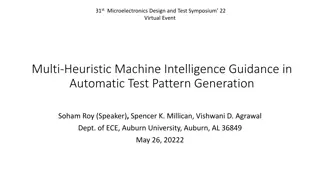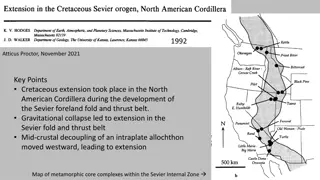Geant4 MicroElec Extension for Microelectronics Applications
The MicroElec extension is a part of the Geant4-DNA framework designed for microelectronics applications, focusing on ionizing cross-section calculations for incident electrons, protons, and heavy ions. It utilizes the Complex Dielectric Function Theory (CDFT) to determine energy loss functions and differential cross-sections. The extension includes processes for inelastic ionization, elastic scattering, and detailed cross-section datasets, essential for simulations in silicon materials. The theory behind MicroElec involves determining the energy loss function based on optical ELF and fitting it with Drude functions to analyze ionizing interactions in different electronic shells. This detailed approach allows for precise simulations of ionizing interactions in microelectronics.
Download Presentation

Please find below an Image/Link to download the presentation.
The content on the website is provided AS IS for your information and personal use only. It may not be sold, licensed, or shared on other websites without obtaining consent from the author.If you encounter any issues during the download, it is possible that the publisher has removed the file from their server.
You are allowed to download the files provided on this website for personal or commercial use, subject to the condition that they are used lawfully. All files are the property of their respective owners.
The content on the website is provided AS IS for your information and personal use only. It may not be sold, licensed, or shared on other websites without obtaining consent from the author.
E N D
Presentation Transcript
MicroElec: The Geant4 extension for microelectronics applications M lanie Raine CEA, DAM, DIF France Geant4 Collaboration Meeting 2015 | PAGE 1 14 SEPTEMBRE 2024 CEA | 10 AVRIL 2012
DESCRIPTION OF THE MICROELEC EXTENSION Based on the existing Geant4-DNA framework, which uses the same initial theory (CDFT) in liquid water. MicroElec extension: In $G4INSTALL/source/processes/electromagnetic/lowenergy 4 classes (2 processes, one model each) Process Interaction Particle Energy range e- 16.7 eV - 100 MeV G4MicroElecInelastic Ionization Proton Heavy ion 50 keV/amu - 10 GeV/amu G4MicroElecElastic Elastic scattering e- 16.7 eV - 100 MeV 2 additional classes: G4MicroElecCrossSectionDataSet G4MicroElecSiStructure Tabulated total and differential cross sections in data files G4EMLOWX.Y Valid in silicon only 14 SEPTEMBRE 2024 | 2 | 2 M lanie RAINE - Geant4 Space Users Workshop
DESCRIPTION OF THE MICROELEC EXTENSION Based on the existing Geant4-DNA framework, which uses the same initial theory (CDFT) in liquid water. MicroElec extension: In $G4INSTALL/source/processes/electromagnetic/lowenergy 4 classes (2 processes, one model each) Process Interaction Particle Energy range e- 16.7 eV - 100 MeV G4MicroElecInelastic Ionization Proton Heavy ion 50 keV/amu - 10 GeV/amu G4MicroElecElastic Elastic scattering e- 16.7 eV - 100 MeV 2 additional classes: G4MicroElecCrossSectionDataSet G4MicroElecSiStructure Tabulated total and differential cross sections in data files G4EMLOWX.Y Valid in silicon only Cross-section calculation = most critical step, before Geant4 14 SEPTEMBRE 2024 M lanie RAINE - Geant4 Space Users Workshop implementation | 3 | 3
BRIEF DESCRIPTION OF THE THEORY Calculation of ionizing cross-section for the generation of electrons by incident electrons, protons and heavy ions: Based on the Complex Dielectric Function Theory (CDFT). Using the procedure described by Akkerman et al. [1]. 1 = CDFT basic quantity: Energy Loss Function Differential Cross Section: )( d ELF ( ) q , Im ) ( q , q + d 1 dq ) = , E ELF ( ) q , q ( Na E q 0 Total Cross Section: Different q depending on incident particle: e- or proton/heavy ion + 2 E E b d ( ) E = ( d ) 0 ( d ) Stopping power: E / 2 d ( ) E S ( ) = N d 0 ( d ) 14 SEPTEMBRE 2024 [1] Akkerman et al., NIM B, vol. 227, 2005. | 4 | 4 M lanie RAINE - Geant4 Space Users Workshop
BRIEF DESCRIPTION OF THE THEORY K-shell L-shell M-shell Determination of the Energy Loss Function: Optical ELF (OELF): ELF at q = 0. Determined from optical exp. data Fitted with a sum of Drude functions 0 10 -2 10 OELF -4 10 2 2 q ( ) q Extension at q 0: (n,k) data Photo-absorption data Fitted OELF = + E E j j 2 m -6 10 e 1 2 3 4 10 10 10 10 Transferred energy (eV) 6 cross-sections, allowing to distinguish 6 different ionizing interactions: Plasmon excitation, Ejection of an electron from the 5 Si electronic shells: M1 (3s), M2 (3p), L1 (2s), L2 (2p) and K (1s) shells. 14 SEPTEMBRE 2024 | 5 | 5 M lanie RAINE - Geant4 Space Users Workshop
EXTENSION OF THE ENERGY RANGE VALIDITY Including relativistic corrections: Up to 100 MeV for electrons (instead of 50 keV) Up to 10 GeV/amu for protons and heavy ions (instead of 23 MeV/amu) 10 2/mg) 0 Stopping power (MeV.cm -1 10 -2 10 PSTAR No corrections MicroElec -3 Relativistic corrections 10 -2 -1 0 1 2 3 4 10 10 10 10 10 10 10 Incident proton energy (MeV) 14 SEPTEMBRE 2024 M lanie RAINE - Geant4 Space Users Workshop | 6 | 6
MICROELECTRONICS EXAMPLE Release of a user example to show how to combine Standard EM or Low Energy EM processes with MicroElec Physics processes (similar to microdosimetry example) 10N, 10 MeV/amu 200 nm Standard EM Standard EM MicroElec 14 SEPTEMBRE 2024 | 7 | 7 M lanie RAINE - Geant4 Space Users Workshop
DESCRIPTION OF THE MICROELEC EXTENSION All calculation details in: A. Valentin, et al., "Geant4 physics processes for microdosimetry simulation: very low energy electromagnetic models for electrons in silicon", NIM B, vol. 288, pp. 66 - 73, 2012. A. Valentin, et al., "Geant4 physics processes for microdosimetry simulation: very low energy electromagnetic models for protons and heavy ions in silicon", NIM B, vol. 287, pp. 124 - 129, 2012. M. Raine, et al., "Geant4 Physics Processes for Silicon Microdosimetry Simulation: Improvements and extension of the energy-range validity up to 10 GeV/nucleon", NIM B, vol. 325, pp. 97 - 100, 2014. 14 SEPTEMBRE 2024 | 8 | 8 M lanie RAINE - Geant4 Space Users Workshop
PERSPECTIVES: Extension to other materials PhD thesis in progress, started in Octobre 2014, in collaboration with ONERA and CNES: Juliette Pierron Refinements in the cross-section calculations for lower-energy interactions: better distinction between plasmon excitation and individual interactions First calculations for Al, Ag and Si Comparison with experimental data: secondary electron emission yield (experiments directly available at ONERA) Implementation in G4 not started yet: To be discussed: generalization of MicroElec classes, to avoid implementing a new process for each new material (appears to be also relevant for G4DNA) Further perspectives: inclusion of surface plasmon 14 SEPTEMBRE 2024 | 9 | 9 M lanie RAINE - Geant4 Space Users Workshop






















